
| Home |
| Intro |
| Current Issue |
| Mailing List |
| Store |
| Strength |
| Subscriber Content |
| ARCHIVES REVIEWS |
| Martialism |
| Pacifism |
| Q & A |
| Cunning-Hammery |
| Advertise With Us |
| Submit An Article |
| Staff |
| Discussion Forum |
| Links |
"Stay 'unreasonable.' If you
don't like the solutions [available to you], come up with your
own."
Dan Webre
The Martialist does not
constitute legal advice. It is for ENTERTAINMENT
PURPOSES ONLY.
Copyright © 2003-2004 Phil Elmore, all rights
reserved.
Forgetting the "Martial" in "Martial Artist"
By Phil Elmore
|
Attack, attack, attack -- come at your target from every possible direction and press until his defenses overload. Never give him time to recover his balance: never give him time to counter. - Heroes Die, Matthew Woodring Stover |
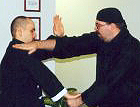 Does
that quote sound fearful to you?
Does
that quote sound fearful to you?
I witnessed a discussion at an Internet forum (not long before writing this column) in which that quote was cited by a participant who saw it in military combatives exponent Tony Manifold's signature line. "Does this," the participant asked, "point to underlying fear?"
A number of individuals -- who would, if asked, describe themselves as martial artists -- responded in the affirmative. The attitude expressed by the quote was indeed very fearful, they opined. It was not a realistic attitude. It betrayed an ignorance of Japanese Budo, the focus of the discussion site in question. It was, in fact, an attitude exemplified by the infamous fictional Karate instructor portrayed by Martin Kove in The Karate Kid.
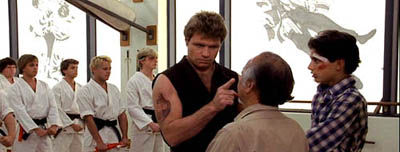
"I hear you jumped some of my students last
night."
One participant said that he felt sorry for those who imagined their lives were in constant danger. Another said that he felt sorry for those whose arts demanded "total aggression." He wondered if a fighter who failed to feel such aggression would simply fail and die.
Still other respondents speculated that such a philosophy would prompt the fighter to leave himself open or to tire himself prematurely, while one or two wondered who or what grants the individual the "moral authority" to use lethal force against another person. Martial arts instructors who promote such attitudes of total aggression were called "naïve." Those who agree with such a philosophy were presumed to suffer from low self-esteem, a lack of confidence, or the inability to exercise judgment in the face of an assault.
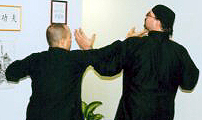 What
motivates a martial artist to look at that quote and see mindless killing,
bullying, bravado, and mental illness? What martial artist in his or her
right mind would claim that it is "great" to be attacked, because when
an attack occurs one is in "total control" of the situation?
What sort of worldview prompts a martial artist to say that one should
"respect" one's attacker? What attitude is behind the opinions
of martial artists who look down on their fellow fighters who carry legal
handguns or tactical folding knives?
What
motivates a martial artist to look at that quote and see mindless killing,
bullying, bravado, and mental illness? What martial artist in his or her
right mind would claim that it is "great" to be attacked, because when
an attack occurs one is in "total control" of the situation?
What sort of worldview prompts a martial artist to say that one should
"respect" one's attacker? What attitude is behind the opinions
of martial artists who look down on their fellow fighters who carry legal
handguns or tactical folding knives?
I submit that martial artists who hold such sentiments are not "martial" artists at all. They have forgotten what martial truly means. They fail to understand the defining component of the arts they practice.

The dictionary definition of "martial."
The martial arts are about fighting. Every martial system has at its core the concept of using physical force against another human being. It does not matter if the art in question is a passive one, meeting initiated force with retaliatory force or some form of redirection. All martial arts were conceived in the forge of human conflict. Even generations removed from its roots and stylized to the point of near uselessness, a martial art is predicated on the concept that human beings may try to hurt or control each other with their bodies -- or with weapons that are extensions of those bodies.
|
At some point in man's evolution, his primal rage compelled him to climb down out of the trees, pick up stones, and take a stand against the animals that had been hunting him for so long. From this rage the art of fighting was born. This inner rage of our ancestors would become the foundation from which many classical and contemporary martial arts styles and systems were built... - Michael Rosenbaum, The Fighting Arts |
To believe you can, with any degree of certainty, "totally control" a given situation is to display such complete ignorance of the reality of fighting that rational discussion is nearly out of the question. Anyone who believes an attacker is someone to be "respected" has never met a human predator ready and willing to gouge out another man's eyeball and pop it. Any martial artist who thinks he or she will have the time and information necessary to assess the intentions of an attacker who has just come from behind to smash a beer bottle over his or her head has no idea just how quickly real attacks occur.
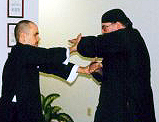 The
martial arts today provide a wide array of ancillary benefits. If you find
an art or fighting system that improves your health and fitness, grants you some
measure of spiritual insight and development, or gives you a social outlet,
great. If studying a particular art makes you more confident, increases
your respect for yourself and others, makes you more responsible, or makes you
more disciplined, wonderful. However, if at any time you are tempted to
think that any of these things, taken separately or together, are what the
martial arts are about, you are mistaken.
The
martial arts today provide a wide array of ancillary benefits. If you find
an art or fighting system that improves your health and fitness, grants you some
measure of spiritual insight and development, or gives you a social outlet,
great. If studying a particular art makes you more confident, increases
your respect for yourself and others, makes you more responsible, or makes you
more disciplined, wonderful. However, if at any time you are tempted to
think that any of these things, taken separately or together, are what the
martial arts are about, you are mistaken.
Baseball isn't about listening to the national anthem, eating pizza or hot dogs, or catching foul balls, though most would say the experience of a baseball game isn't the same without these things. Can you imagine the sort of team that would result if a given coach focused on these things to the exclusion of training his players to hit and throw baseballs?
For a martial art to be a martial art, rather than some other form of physical expression (some other "art" entirely), its focus must remain on fighting. A truly accomplished warrior may renounce violence -- but only his or her mastery of violence makes this possible. If the style or system you study leaves you unable to defend yourself in a realistic self-defense scenario, it may indeed be an art -- but it is not martial at all. Its practitioners delude themselves if they believe that it is.
In the same vein, a martial art or martial artist whose attitude towards weapons is one of contempt, mistrust, fear, or condescension tells you volumes about its, his, or her "martialism." Weapons are force multipliers -- tools that perform the same function as hammers, levers, and pliers in that they make it easier to accomplish a specific task. As the purpose of a martial art is to deliver force against another human or group of humans, only the most ignorant of martial artists would dismiss or reject tools that make performing this task more efficient and less risky. There is no such thing as an immoral tool. There are only immoral tool users.
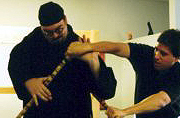 All
self-defense involves risk. Training in a martial art is one way of
improving your odds in the gamble that is a self-defense scenario.
Responsible carry of a legal weapon is another means of improving those odds, of
giving yourself more options.
All
self-defense involves risk. Training in a martial art is one way of
improving your odds in the gamble that is a self-defense scenario.
Responsible carry of a legal weapon is another means of improving those odds, of
giving yourself more options.
Weapons and martial arts training are not magic guarantees of success when faced with an attack, of course. You may always encounter someone faster, bigger, stronger, or better armed. That, however, is why we train. Learning martial skills and carrying martial tools improves our chances but does not remove the risk that characterizes the gamble. You can't win every bet, but you can cheat as much as possible.
These concepts all come back to the concept of aggression. Aggression -- forward drive, seizing the initiative -- is not anger. Anger can be channeled, of course, but if it is not controlled and used properly it works against the fighter. Aggressive domination of an encounter, however, is not reckless fury. It is not fearful and spastic hurling of one's body into danger without regard for covering one's vital areas.
|
Holding down the pillow means not letting someone raise his head. In martial arts, in the course of dueling, it is bad to be maneuvered around by others. It is desirable to maneuver opponents around freely, by whatever means you may. ...Stopping an opponent's attack at the initial outset, not letting him follow through, is the sense of 'holding down the pillow.' ...First, doing whatever you do scientifically, thwart the opponent's very first impulse to try something, thus foiling everything. To manipulate opponents in this way is mastery of the art of war, which comes from practice. - Miyamoto Musashi, The Book of Five Rings |
Overwhelming an opponent with aggression, when done by a fighter who understands the principles of fighting and is skilled and experienced in their application, will always decide a violent altercation. It will also decide a violent altercation in favor of the assailant if the defending "martial" artist fails to grasp the importance of it.
Those who understand the purpose of the martial arts and the foundation for all fighting systems do not live their lives in fear. They are, however, realistic about their chances, about the myriad of factors they know they cannot control when faced with attacks by unknown assailants possessing equally unknown motivations and intents. Real fighting is messy, brutal, aggressive, and fast. It is not a dance, it is not a kata, it is not a form, and it is not an exercise.
We forget this at our peril.